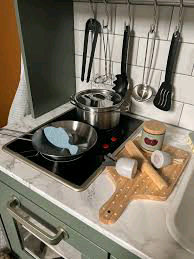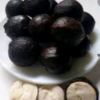KITCHEN HACKS
Kitchen hacks are clever and efficient techniques, shortcuts, or tips that help make cooking and food preparation easier, more convenient, and sometimes even more cost-effective. These hacks can involve using everyday items in unconventional ways or employing creative methods to solve common kitchen problems.
Kitchen hacks are important because they can save time, reduce waste, and enhance the overall cooking experience. They can also make cooking more accessible for beginners and help experienced cooks streamline their processes.
Here are some of different kitchen hacks:
- Place a wooden spoon across a boiling pot to prevent it from overflowing.
- Keep brown sugar soft by placing a slice of bread in the container.
- Use a rubber band to help open stubborn jar lids.
- Microwave citrus fruits for a few seconds to make them easier to juice.
- Use a spoon to peel ginger without wasting much of it.
- Keep lettuce and other greens fresh by storing them with a paper towel.
- Plantain Storage: Store unripe plantains in a bag with a ripe banana to help them ripen faster.
- Pepper Preservation: Blend and freeze excess peppers in ice cube trays for easy use in cooking.
- Yam Peeling: Soak yams in hot water for a few minutes before peeling to make the skin easier to remove.
- Onion Odor Removal: Rub your hands with salt or lemon juice to remove onion smell after chopping.
- Okra Slicing: Use a small knife to make a slit lengthwise along the ridges of okra for even cooking and less sliminess.
- Moin Moin Wrapper: Use banana leaves to wrap moin moin for added flavor and aroma.
- Coconut Grating: Microwave a coconut for a few minutes to make grating the flesh easier.
- Pounded Yam Smoothness: Add a small amount of warm water to leftover pounded yam to make it smoother when reheated.
- Cassava Peeling: Soak cassava in water before peeling to prevent itchiness caused by the sap.
- Egusi Mixing: Mix ground egusi with a bit of water before adding it to soups to prevent lumps.
- Rice Storage: Keep rice fresh by adding a dried pepper or bay leaves to the container to deter pests.
- Tomato Paste Preservation: Freeze leftover tomato paste in an ice cube tray for portioned use.
- Tough Meat Tenderizing: Marinate tough meat in papaya or pineapple juice to tenderize it before cooking.
- Store onions in pantyhose to extend their shelf life.
Keep cheese fresh by wrapping it in wax paper and then in plastic wrap - Use a muffin tin to make perfectly portioned omelets.
- Put a damp paper towel under a cutting board to prevent it from slipping.
- Freeze leftover coffee in ice cube trays to use in iced coffee.
- Keep plastic bags organized using an empty tissue box.
- Use dental floss to cut soft foods like cheese or cake.
- Revive stale bread by brushing it with water and toasting it.
- Use a potato peeler to make thin vegetable ribbons for salads.
- Place a damp paper towel over a bowl of greens to keep them crisp.
- Use a colander to evenly distribute powdered sugar over desserts.
- Keep avocados from turning brown by storing them with onions.
- Crayfish Grinding: Add a little salt to crayfish before grinding to prevent it from sticking to the grinder.
- Smoother Starchy Sauces: Use a small amount of oil in starchy soups to prevent them from becoming too sticky.
- Ripe Plantain Storage: Store ripe plantains in the refrigerator to extend their shelf life.
- Palm Oil Separation: If palm oil solidifies, place the container in warm water to liquify it again.
- Pepper Roasting: Roast peppers over an open flame or in the oven for a smoky flavor before blending.
- Storing Beans: Store beans with dried pepper or neem leaves to keep pests away.
- Leafy Greens Storage: Store leafy greens in a plastic bag with a paper towel to absorb excess moisture and keep them fresh.
- These kitchen hacks can help simplify cooking and food preparation in Nigerian households.
- Tomato Skin Removal: Score the bottom of tomatoes with a cross and dip them in hot water for a few seconds to easily peel off the skin.
- Leafy Vegetable Cleaning: Soak leafy vegetables in a bowl of water with a little salt or vinegar to help remove dirt and insects.
- Beans Softening: Soak beans in water overnight or for several hours to soften them before cooking, reducing cooking time.
- Palm Fruit Processing: Boil palm fruits before extracting the oil to make it easier to separate from the flesh.
- Melon Seed Drying: Dry melon seeds in the sun before grinding them for a smoother consistency.
- Yam Preservation: Coat yam slices with oil or palm oil to prevent them from turning brown when exposed to air.
- Grilling Fish: Grill fish on a bed of banana leaves to prevent sticking and add flavor.
- Efo Riro Thickening: Blend a small amount of boiled vegetables and stir into efo riro soup for natural thickening.
- Crayfish Flavor Enhancement: Roast crayfish before grinding to enhance its flavor in dishes.
- Pounded Yam Freshness: Add a bit of hot water to leftover pounded yam when reheating to restore its texture.
- Palm Oil Stain Removal: Use a mixture of palm oil and ash to remove stubborn stains from dishes and pots.
- Locust Bean (Iru) Preparation: Soak locust beans in water and rinse before use to reduce its strong odor.
- Peeling Beans Easily: Boil beans for a few minutes and then soak them in cold water before peeling to make the process easier.
- Fufu Smoothness: Stir fufu constantly when cooking to ensure it’s smooth and free from lumps.
- Egg Preservation: Coat eggs with a thin layer of oil to help preserve their freshness and extend their shelf life.
- Starch Softening: Add a bit of warm water to leftover starch before reheating to maintain its smooth texture.
- Achi and Ofor Thickeners: Mix achi or ofor with a small amount of cold water before adding to soups for better dispersion.
- Palm Nut Processing: Use a mortar and pestle to crack open palm nuts before boiling for palm nut soup.
- Moin Moin Leaf Wrapping: Use fresh leaves like uziza or scent leaves to wrap moin moin for added flavor.
- Ewa Aganyin Sauce Enrichment: Mix ground crayfish and palm oil with Ewa Aganyin sauce for extra flavor and richness.




